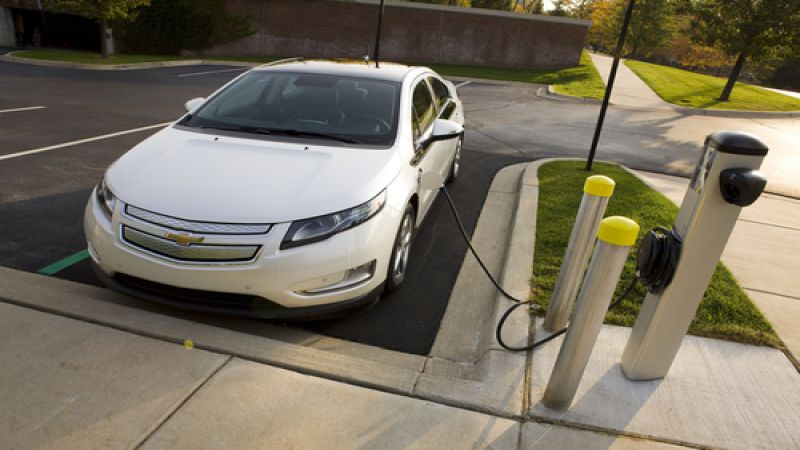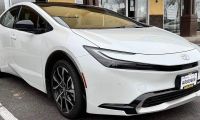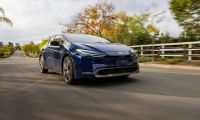Does the 35 miles (or so) electric range of the Chevy Volt mean that Volt owners are limited to 35 miles of electric driving per day? Over the weekend a Florida based Chevy Volt owner, Edward Ellyatt, excitedly reported having driven 190.6 electric miles in one day with his Chevy Volt. That's way beyond the 35 mile electric range limit. He is part of a group of Volt owners using the website, VoltStats.net, to share mileage results, achievements and friendly competition with each other to see which of them can make the most of the Chevy Volt.
The Chevy Volt's 35 mile electric range is a factoid used by some of the Volt Naysayers to dismiss that car. What Ellyatt did last weekend was to blow up, and demolish, another electric car myth. Even a car with as short an electric range as the Volt can accomplish a significant chunk of electric driving in a day.
The Chevy Volt is a plug-in hybrid electric car, where the battery pack allows a 35 mile or so electric range, with the gasoline engine providing power to extend the total driving range. GM's design goals for this dual drive train is to fit into the typical daily driving pattern. Research shows most people drive 40 miles or less per day, meaning the Volt's 35-40 mile electric range will handle typical daily driving tasks, and the gasoline engine is a backup to extend range and prevent range anxiety.
What makes Ellyatt's accomplishment interesting is that it goes beyond the math of Chevy Volt Recharging. A full recharge of the Volt's 14 kilowatt-hour battery pack, after the 35 miles (or so) of driving, requires 4 hours or so at a J1772 charging station. Scribbling on the back of an envelope we calculate that 190 miles of electric driving would require 6 recharging sessions, each requiring four hours or so, meaning as many as 24 hours of recharging time, leaving one to wonder just how Ellyatt did the deed.
Especially as Florida weather is already in the 80's during the day, and he drove with the air conditioner on so he and his wife remained comfortable.
How did he do it?
First trick was to drive two segments with the cruise control at 40 miles/hr, on level ground, with few stops. Each of those segments Ellyatt achieved 50+ miles of electric range. How did that work when the EPA says the Volt gets 35 miles of electric range? As the automakers keep saying, the range figures are estimates affected by your driving habits. The same holds true in gasoline cars, where leadfooted street racers get lower miles/gallon than do the careful hypermilers. By staying below 40 miles/hr Ellyatt was able to drive more efficiently, use less energy, and get a longer electric range per charge.
One of those 50+ mile segments lasted 51.3 miles, and the car had 7 miles of range left. Ellyatt says his next goal is to see just how far one can go on a single charge, and believes the car can go over 60 electric miles. Yes, 60 electric miles on a car rated for 35 electric miles.
That covered a bit over 100 miles of the 190 total miles, so what about the rest, a bit less than 90 miles? That distance can be covered by 3 full recharging sessions which would give 105 miles of driving range by the EPA rating of the car. However, Ellyatt reports that he relied on "opportunity charges" and purposely did not fully recharge the car during the day.
Avoiding a full recharge is another trick. If you watch the charging rate, in kilowatts, throughout a charging session, during the last part the power level drops very low. What's happening is the battery management system is keeping the charger at a low setting, to avoid overcharging, while at the same time balancing the battery pack to ensure each battery cell is fully charged. In typical charging usage this is required because a balanced battery pack is a happy battery pack. However, it is not necessary to fully recharge the pack on every charge session.
Because Ellyatt's goal was to achieve maximum range, going for partial recharges was a more efficient use of time. The low charge rate at the tail end of the charging session does not add much power (range) to the battery pack. Range is determined by the kilowatt-hours in the battery pack, and by the balancing phase most of the kilowatt-hours have been put into the pack. Stopping the recharge early means the time spent with the car plugged in is during the phase where a lot of miles is being put into the pack.
This would entail driving a few miles, stopping at a recharging station, pluging in to start a charging session, stopping the charging session before it's finished, and repeating this throughout the day. The 3.3 kilowatt charger on-board the Chevy Volt provides about 12 miles of driving range per hour of charging.
While this made for an interesting experiment, it could work in normal daily life as well. Suppose you have 10 errands to run on a given day. You'll be out driving all day long, and drive much more than 35 miles total electric range of the Volt. Suppose additionally each place you stop has a charging station. Even an errand as short as spending fifteen minutes picking up medicine at the drug store, fifteen minutes of charging adds about 4 miles of range to the car. Ten stops, each allowing fifteen minutes of charging time, is 40 miles of electric driving range. Is 75 miles total electric driving range enough to handle a few errands around town?
This pattern is true for every kind of electric car. The more frequently an electric car driver can plug in to charge while doing other things, the further can be their total driving distance. Additionally some of the electric cars have a more powerful on-board charger allowing for an even longer total driving range per day. The Ford Focus Electric and Coda Sedan both have a 6.6 kilowatt charger, charging the car at twice the rate of the 3.3 kilowatt chargers on the Nissan Leaf, Chevy Volt and Mitsubishi i-MiEV. The 2013 Nissan Leaf will also have a 6.6 kilowatt charger option available. The Nissan Leaf and Mitsubishi i-MiEV both can be outfitted with a CHADEMO port allowing an 80% recharge in under 30 minutes, and CHADEMO charging stations (DC Fast Charge) are being installed in Chicago, California and other places around the country.
The electric driving range on the EPA sticker doesn't have to be the limit to total driving range. The more charging stations are available at the places we go, the more often electric car drivers can charge, and the more useful will be their cars. Is the solution for "range anxiety" to simply have enough charging stations?












Comments
Good comments about
Permalink
Good comments about opportunity charging and also about how you can get to 80% of full recharge a lot faster than getting to 100%. I think any cafe that lets me plug in while I am eating lunch will get my business. Even 120V can make a difference in 30 minutes! A Volt doesn't need to charge, but it is nice to cover as many miles as possible using American electricity instead of gas that is produced using oil that is imported half of the time.
If you look at
Permalink
If you look at voltstats.net.. that is not even the best..
2011-00584 WATT UP
did 254.45
on 09/03/2011
I have a Generation 2 volt.
Permalink
I have a Generation 2 volt. The Gen 2 volt is rated for 53 miles. I've taken my volt to 74 miles on a single charge. This is an amazing car. Any electric car that can go 74 miles on an 18.5kwh battery is amazing.
I was looking for a preowned
Permalink
I was looking for a preowned lead not now I now am considering a 2013 volt drive 39 miles one way and have charger possibly I can use employees normally must allow hotel guests to use the Chargers any thoughts?
If your commute is local
Permalink
In reply to I was looking for a preowned by Edinas (not verified)
If your commute is local roads, the first generation volt would be sufficient, however the highway will eat your range at higher speeds, and you won't get your 39 miles of range. To get mile for mile on the highway, you will have to maintain 55mph.
Tim, the 2011 and 2012 are a
Permalink
In reply to If your commute is local by Tim (not verified)
Tim, the 2011 and 2012 are a bit shorter range than than the 13 through 15s. And the speed I get the best results on the interstate is 63 or 64 mph, not 55. My 13 gets around 44 to 45 miles around town during the 9 warmer months and about 40 to 41 at 63 mph. But 67 drops that down to 38. At 55 I get a bit more miles than the stop start around town, about 45 or 46 miles but it is too slow to not be a pain to other drivers.
YMMV.
I get anywhere from 25 to 35
Permalink
I get anywhere from 25 to 35 miles per charge. I do highway driving....
Just bought a 2013 with 125k
Permalink
Just bought a 2013 with 125k miles and a lifetime mpg of 43.3. Who ever drove this before barely touched the battery. Did a full discharge this morning with about half onhighway at 65mph plus about half in city. The city driving I did about half as a hypermiler and half trying to drive like a "normal person".
Had my AC and upgraded stereo system on the whole time and still got 39.5 miles on all electric.
KWH used came in at 10.2 which is just half a kwh below the original 10.7kwh "usable" capacity (the software only charges to 80% and kicks in gas at 30% charge to extend the overall battery life).
I hope that as these age they offer a software update to expand that from 30% to 80% up to 15% to 95%. That could essentially give the battery a second life and bump it back up to original specs albeit at the expense of instant acceleration when the battery is low.
At 10.7kwh and 38 miles rated range they are estimating about 3.5 miles per kwh. I've gotten as high as 6 miles per kwh on empty back roads at night meaning I could potentially get over 60 miles a charge under semi reasonable conditions and driving habits. Not bad for a 7 year old car that originally retailed for $45,000 in my area and I picked up for $9,700.
Should save about $750 in fuel per 10,000 miles driven when compared to a 35mpg car at $3.50 a gallon and grid electricity at 13c per kwh. At these rates it's costing about 2.4c per mile to drive. If you have a DIY off grid solar and pro rate the cost of your panels out over 30 years you can easily come in under a penny a mile and this doesn't count skipping oil changes and other routine maintenance ICE vehicles need. I DID keep my 20 year old Ranger (which I hypermile at 35 to 45 mpg) for the couple dozen times a year I need a truck, but I love this car.
Sorry to see it discontinued. I hope something similar comes out (and the general public takes the time to understand it and not dismiss it because of confusion and lack of education). 40 to 50 miles of grid power electric range is great for the VAST majority of drivers, however, someone who commutes 150 miles a day or more might actually save more gas with a Prius. I'm a bit disappointed by the combined mpg on this when it enters "hybrid mode". Still, my driving habits will probably result in me burning less than half a gallon of gas a month with this because it's a perfect match for my driving routines (less than 30 miles a day 95% of the time).
This article contains many
Permalink
This article contains many inaccuracies. First of all the Volt charges at 12A, which is 2.9 KW. That is the most it can take and it's probably the slowest available. So charging the car takes a minimum of 3.5 hours from empty. Period. It only charges to 80% of the battery's real capacity, so the Volt does not need to slow its charging rate significantly before the end of its cycle. Yes the Volt is fast to charge due to the small battery, and I have driven my 2012 quite far on battery in a day with recharges, say 100 mi, but the only way to get these unrealistic numbers is with a strong tailwind and a very slow speed on cruise or perhaps downhill all the way (LOL), in other words not using the car in a practical manner. Or perhaps if you want to pull an all-nighter so you are effectively fitting two days in one, and driving circles around your house so there is always charging available every time you run out of EV range, plus a bed to sleep in while you wait. Still the world's best car. Normal start and stop driving, with a gentle driving style, will get you more range than continuously discharging the battery at speed on the highway as with any PHEV. There is no need for exaggerations or for contorting yourself into a pretzel to enjoy all the advantages of the Volt!
How to improve the mileage on
Permalink
How to improve the mileage on my 2017 VOILT Can set the charge time so I am not on peak time. dose the charger shout off when the battery is full charge??